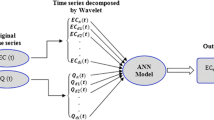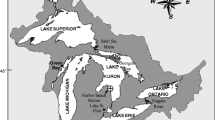Abstract
The study of modern seafloor hydrothermal activity and its mineralization has become one of the focuses of global geoscience. Accurate prediction of possible seafloor hydrothermal active fields is the basis of all research work. The detecting method for new seafloor hydrothermal activity still is mainly dependent on marine site investigation. This includes a series of temperature, turbidity, and geochemical anomaly investigations using submarine cameras and manned diving investigation. Both of these require expensive financial, human, and material resources. In order to realize the accurate prediction of potential hydrothermal activity areas in a low cost manner, with strong pertinence, and a wide range, we propose a prediction method of seafloor hydrothermal active region based on Wavelet Neural Network. First, we integrated the hydrothermal position information from the InterRidge Vents Database with the hydrothermal temperature information form the Argo Database to construct a data set. Then, we combined wavelet analysis with an artificial neural network to create a wavelet neural network optimization algorithm. Finally, the temperature and salinity data were input to the wavelet neural network to predict the seafloor hydrothermal active region. Sevenfold cross validation was used to evaluate the performance of the model and 90.43% prediction accuracy was achieved. The results of experiments show that salinity is not related to the existence of hydrothermal activity fields but rather that the surrounding water temperature has a strong correlation with hydrothermal existence. Therefore, it is effectively feasible to use the wavelet neural network model with an input of seawater temperature to predict seafloor hydrothermal activity fields. Although artificial neural network cannot completely replace traditional hydrothermal exploration technology, it can provide a valuable reference with a strong target.








Similar content being viewed by others
References
Bilenker LD, Romano GY, Mckibben MA (2016) Kinetics of sulfide mineral oxidation in seawater: implications for acid generation during in situ, mining of seafloor hydrothermal vent deposits. Appl Geochem 75:20–31
Cann JR, Strens MR, Rice A (1985) A simple magma-driven thermal balance model for the formation of volcanogenic massive sulphides. Earth Planet Sci Lett 76(1):123–134
Guo S, Lu Y, Cen X et al (2017) Temperature and turbidity anomalies and flux estimation of hydrothermal plume in Explorer Ridge in the Northeast Pacific Ocean. Acta Oceanol Sin (in Chinese) 39(12):1–11
Ingebritsen SE, Geiger S, Hurwitz S et al (2010) Numerical simulation of magmatic hydrothermal systems. Rev Geophys 48(1):1002
Karlen DJ, Price RE, Pichler T et al (2016) Changes in benthic macrofauna associated with a shallow-water hydrothermal vent gradient in Papua New Guinea. Pac Sci 64(3):391–404
Li H (2008) Simulation experimental study on fluid flow in sulfide deposits of modern seafloor hydrothermal [dissertation]. China: Ocean University of China. 2016:1–14
Liu L, Zhai S (2006a) The basic mathematic model for normal black smoker system and hydrothermal mega plume. Acta Oceanol Sin (in Chinese) 28(6):53–60
Liu L, Zhai S (2006b) The model of hydrothermal system with permeating seawater embranchment simulating effect of dilution on hydrothermal flow. Acta Oceanol Sin (in Chinese) 30(4):80–86
Liu L, Zhou X, Liu X (2013) Threshold analysis of gene expression data based on genetic algorithm and LVQ neural network. Periodical Ocean Univ China (in Chinese) 43(12):111–116
Liu L, Liu M, Ma M (2015) Function Clustering Self-Organization Maps (FCSOMs) for mining differentially expressed genes in Drosophila and its correlation with the growth medium. Genet Mol Res Gmr 14(3):11658–11671
Liu W, Zheng L, Tao C et al (2011) On the feature of seafloor hydrothermal systems’ evolutionary and its mineralization in Mid-Ocean Ridge. J Mar Sci (in Chinese) 29(1):25–33
Liu L, Qu J, Zhou X et al (2014) Discovery of a strongly-interrelated gene network in corals under constant darkness by correlation analysis after wavelet transform on complex network model. PLoS ONE 9(9):e92434
Liu L, Zhao T, Ma M et al (2016) A new gene regulatory network model based on BP algorithm for interrogating differentially expressed genes of Sea Urchin. Springerplus 5(1):1911
Mussardo G (2015) Fault geometry and permeability contrast control vent temperatures at the Logatchev 1 hydrothermal field Mid-Atlantic Ridge. Geology 43(1):51–54
Nozaki T, Ishibashi J, Shimada K et al (2016) Rapid growth of mineral deposits at artificial seafloor hydrothermal vents. Sci Rep 6:22163
Raza K (2016) Reconstruction, topological and gene ontology enrichment analysis of cancerous gene regulatory network modules. Curr Bioinform 11:243–258
Raza K, Alam M (2016) Recurrent neural network based hybrid model for reconstructing gene regulatory network. Comput Biol Chem 64:322–334
Seewald JS, Seyfried WE (1990) The effect of temperature on metal mobility in sub-seafloor hydrothermal systems: constraints from basalt alteration experiments. Earth Planet Sci Lett 101(2–4):388–403
Song X, Lv Z, Li G et al (2016) Numerical analysis of characteristics of multi-orifice nozzle hydrothermal jet impact flow field and heat transfer. J Nat Gas Sci Eng 35:79–88
Song X, Lv Z, Li G et al (2017) Numerical analysis on the impact of the flow field of hydrothermal jet drilling for geothermal wells in a confined cooling environment. Geothermics 66:39–49
Tao C, Chen S, Baker ET et al (2016) Hydrothermal plume mapping as a prospecting tool for seafloor sulfide deposits: a case study at the Zouyu-1 and Zouyu-2 hydrothermal fields in the southern Mid-Atlantic Ridge. Mar Geophys Res 38:3–16
Wang X, Zhai S, Du T et al (2005) Research models of modern seafloor hydrothermal activities. Mar Sci (in Chinese) 29(5):60–65
Wang X, Wu L, Zeng Z et al (2012) Automatic calculation on the temperature anomaly of a marine hydrothermal plume. Acta Oceanol Sin (in Chinese) 34(2):185–191
Xia J, Han N, Ren H (2009) Parameters and model analysis for the deep-sea hydrothermal plume. Earth Sci Front (in Chinese) 16(6):48–54
Xie Y, Wu S, Yang C (2016) Generation of electricity from deep-sea hydrothermal vents with a thermoelectric converter. Appl Energy 164:620–627
Ye F, Bao Y (2016) Study of hydrothermal plume transport range in a stratified background. J Trop Oceanogr (in Chinese) 35(5):97–102
Zhai S, Li H, Yu Z et al (2005a) Advances in the investigation technology of modern seafloor hydrothermal activities. Adv Earth Sci (in Chinese) 22(8):769–776
Zhai S, Wang X, Yu Z et al (2005b) Heat and mass flux estimation of modern seafloor hydrothermal activity. Acta Oceanol Sin (in Chinese) 27(2):115–121
Acknowledgements
The authors would like to thank National Key R&D Program of China (2018YFC1311900) and the natural science foundation of Shandong province (ZR2018MF006) for the support to this work.
Author information
Authors and Affiliations
Corresponding author
Additional information
Publisher's Note
Springer Nature remains neutral with regard to jurisdictional claims in published maps and institutional affiliations.
Rights and permissions
About this article
Cite this article
Liu, L., Lu, Z., Ma, D. et al. A new prediction method of seafloor hydrothermal active field based on wavelet neural network. Mar Geophys Res 41, 19 (2020). https://doi.org/10.1007/s11001-020-09420-y
Received:
Accepted:
Published:
DOI: https://doi.org/10.1007/s11001-020-09420-y




